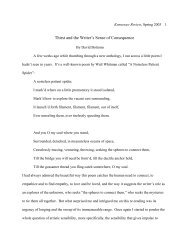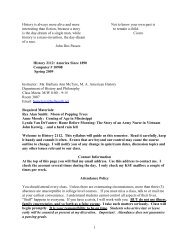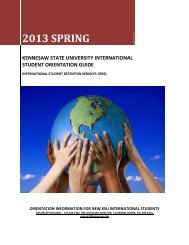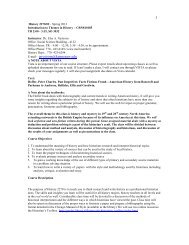Food, Gender and Cultural Hegemony - Kennesaw State University
Food, Gender and Cultural Hegemony - Kennesaw State University
Food, Gender and Cultural Hegemony - Kennesaw State University
Create successful ePaper yourself
Turn your PDF publications into a flip-book with our unique Google optimized e-Paper software.
Cualli 142<br />
insinuated into Spanish food culture through occasional "inventions" for<br />
ceremonial occasions. By the end of the sixteenth century the day was normally<br />
begun <strong>and</strong> concluded with hot cups of chocolate, now permitted for all classes.<br />
Corn, beans, squash <strong>and</strong> chiles were an established part of the creole kitchen. The<br />
presence of indigenous women in Spanish kitchens no doubt helped immeasurably.<br />
Pulque also became generally available, <strong>and</strong> was gradually commercialized. 1<br />
III. The Story of Mole: Genesis of a National Dish<br />
Turkey mole is commonly claimed as the "National Dish" of Mexico, <strong>and</strong><br />
also as an "indigenous food." The origin or provenance of turkey mole is more<br />
than slightly controversial, though it really comes down to which ingredients are<br />
viewed as critical to the essence of the mole. Nahua women made their most<br />
important contribution through the "expert blending of chiles to create subtle<br />
flavors, a skill that Spanish nuns learned from their American sisters. Moreover,<br />
the metate remained the mole-making utensil of choice until the twentieth-century<br />
invention of electric blenders," (Pilcher 26). Its identity as a fiesta or ceremonial<br />
food for many occasions increases the proprietary sense of ethnic <strong>and</strong> regional<br />
groups about this celebrated food. Scholars disagree, pointing to the broad<br />
spectrum of ingredients that can be included, <strong>and</strong> the many regional variations in<br />
its preparation (Friedl<strong>and</strong>er 96) 1 . 1 Mole even appears in Europe, in the cookbook<br />
of Pope Pius V by 1570, <strong>and</strong> became known as an elegant banquet food but not<br />
extremely expensive (Vargas <strong>and</strong> Casillas 167). In a way it is this disagreement<br />
about origins <strong>and</strong> essence that permits both Nahua <strong>and</strong> Spanish to see mole as<br />
essentially theirs, <strong>and</strong> allows Turkey mole to be seen as a national cuisine.<br />
We know from Sahagun that the Nahua prepared turkey as a kind of stew<br />
with various chile sauces. Some also included various nuts, squash seeds <strong>and</strong><br />
vegetables. Such a dish is illustrated in the Codex Mendoza (Codex Mendoza 86).<br />
Also, Spanish cuisine featured stews with a variety of Arabic <strong>and</strong> East Asian<br />
spices. The existence of these dishes in each culture already gives each culture a<br />
reason to claim the mole as theirs.<br />
The first prominent Mexican story about the origins of the dark Mole<br />
Poblano (which Jeffrey Pilcher refers to as a legend) is that in 1680 the Dominican<br />
[Type text]
















